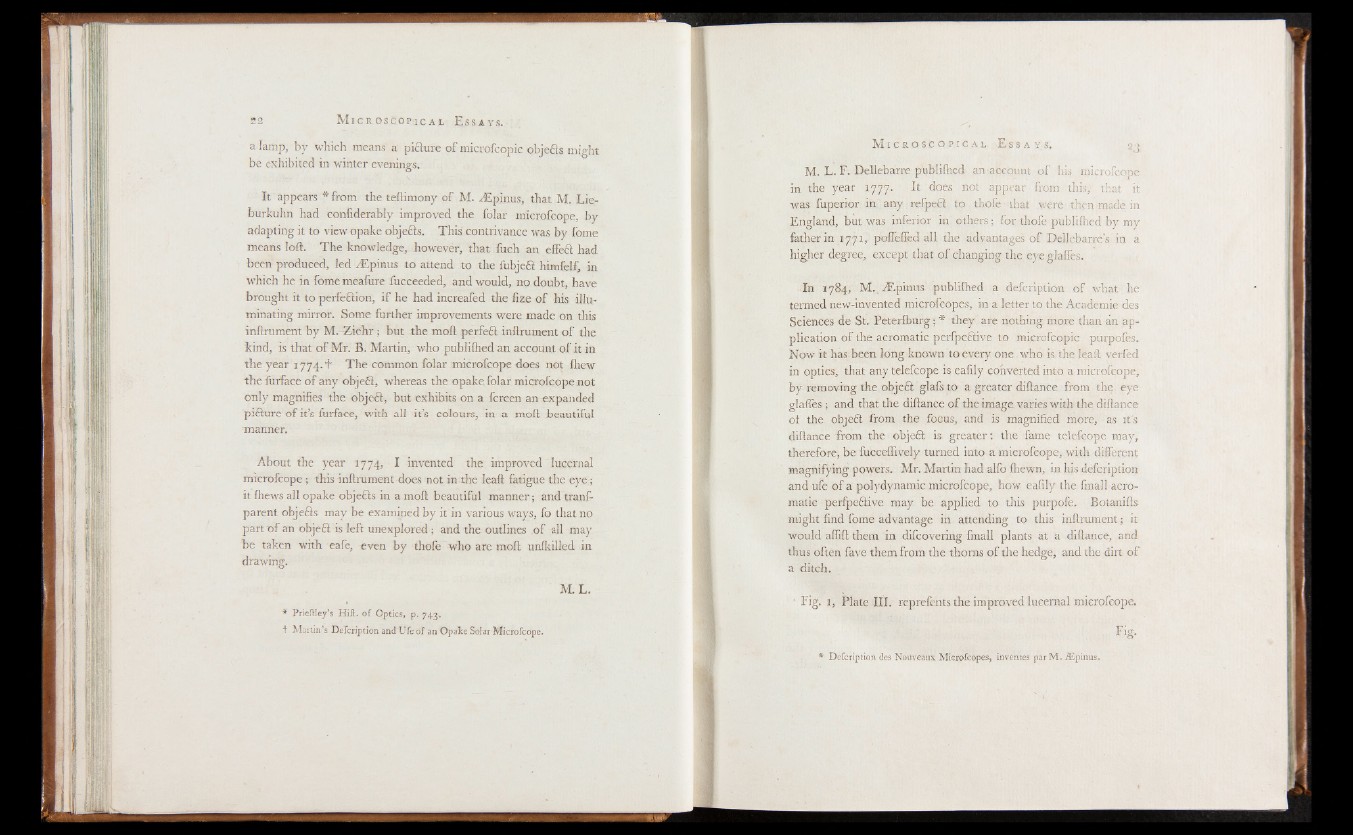
a lamp, by which means a picture o f microfcopic objefis might
be exhibited in winter evenings.
It appears * from the teflimony of M. ./Epinus, that M. Lie-
burkuhn had confiderably improved the folar microfcope, by
adapting it to view opake objefts. This contrivance was by fome
means loft. The knowledge, however, that fuch an effeft had
been produced, led riEpinus to attend to the fubjeft himfelf, in
which he in fome meafure fucceeded, and would, no doubt, have
brought it to perfeftion, i f he had increafed the fize o f his illuminating
mirror. Some further improvements were made on this
inftrument by M. Ziehr ; but the moll perfeft inftrument o f the
kind, is that o f Mr. B. Martin, who publilhed an account o f it in
the year 1774.+ The common folar microfcope does not lhew
the furface o f any objeft, whereas the opake folar microfcope not
only magnifies the objeft, but exhibits on a fcreen an expanded
pifture o f it’s furface, with all it’s colours, in a mod beautiful
manner.
About the year 1774, I invented the improved lucernal
microfcope ; this inftrument does not in the leaft fatigue the e y e ;
it fhews all opake objefts in a moft beautiful manner; and tranf-
parent objefis may be examined by it in various ways, fo that no
part o f an objefl is left unexplored ; and the outlines o f all may
be taken with eafe, even by thofe who are moft unfkilled in
drawing.
M .L .
* Prieflley’s Hill, of Optics, p. 743,
+ Martin’s Defcription and Ufe of an Opake Solar Microfcope.
M. L. F. Dellebarre f/qblifliecl an account o f his microfcope
in the year 1777, It does not appear from this, that it
was fuperior in any refpeft to thofe that were then made in
England, but was inferior in others; for thofe publilhed by roy
father in 1771, pofleffed all the advantages o f Dellebarre’s in a
higher degree, except that of changing the eye glaffes.
In 1784, M._ AT.pinus publilhed a defcription of what he
termed new-invented microfcopes, in a letter to the Academie des
Sciences de St. Peterfburg; * they are nothing more than an application
o f the acromatic perlpeftive to microfcopic purpofes.
Now it has been long known to every one who is the leaft verfed
in optics, that any telefcope is eafily converted into a microfcope,
by removing the object glafs to a greater diftance from the eye
glafles ; and that the diftance o f the image, varies with the diftance
o f the objefl from the focus, and is magnified more, as it’s
diftance from the object is greater: the fame telefcope may,
therefore, be fucceflively turned into a microfcope, with different
magnifying powers. Mr. Martin had alfo fhewn, in his defcription
and ufe o f a polydynamic microfcope, how eafily the fmall acromatic
perfpeflive may be applied to this purpofe. Botanifts
might find fome advantage in attending to this inftrument; it
would aflift them in difeovering fmall plants at a diftance, and
thus often fave them from the thorns o f the hedge, and the dirt o f
a ditch.
• Fig. 1, Plate III. reprefents the improved lucernal microfcope.
Fig.
* Defcription des Nouveaux Microfcopes, inventes parM. iEpinus.